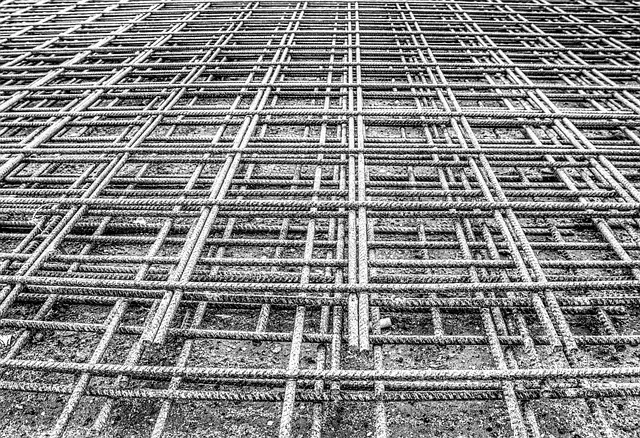This text emphasizes the importance of Residential Foundation Repair for maintaining home structural integrity. Common concrete slab issues like cracks, dips, and uneven surfaces are caused by environmental factors and structural wear, such as differential settling and heave. Early detection through regular inspections is crucial to prevent minor problems from becoming costly repairs. Various repair methods, including structural jacking, concrete patching, and steel beam underpinning, address different foundation issues. Non-destructive testing (NDT) techniques aid in safe and precise early detection. Preventative measures like proper compaction, drainage, and reinforced pouring reduce the risk of damage. Choosing a reputable contractor with transparent pricing and guaranteed work is essential for successful repairs. Understanding repair costs tailored to each project's unique needs ensures fair pricing. Proper post-repair care, including regular inspections and moisture control, safeguards investments in residential foundation repair. Real-world case studies demonstrate the transformative power of these services in restoring damaged homes to their original integrity.
“Concrete slab repair is a crucial aspect of maintaining the structural integrity and longevity of your home’s foundation. This comprehensive guide explores various aspects of residential foundation repair, from understanding common issues like cracks, settlement, and water damage, to effective early detection methods. We delve into advanced non-destructive testing techniques, offer insights on prevention, and provide expert tips for choosing the right contractor and estimating costs. Discover successful case studies, post-repair care advice, and learn how proactive measures can safeguard your home’s foundation.”
Understanding Concrete Slab Issues: Common Problems in Residential Foundations

Concrete slab issues are common problems affecting residential foundations, often caused by various environmental factors and structural wear over time. Cracks, dips, and uneven surfaces can indicate a range of potential problems, from minor settlement to more severe structural damage. One of the primary concerns is differential settling, where different parts of the foundation react differently to changes in soil moisture or temperature, leading to cracks and misalignments.
Another prevalent issue is heave, which occurs when the soil beneath the slab expands due to moisture, causing the concrete to lift and potentially crack. Settling and heave can result in not only cosmetic damage but also compromise the structural integrity of the foundation, making it crucial for homeowners to address these issues promptly. Regular inspection and timely repair are key to maintaining a robust residential foundation.
The Importance of Early Detection for Effective Repair

Early detection is key when it comes to concrete slab repair, as it allows for effective and efficient solutions. Neglecting minor cracks or signs of damage can lead to more significant issues over time, potentially compromising the structural integrity of your property, especially in the case of residential foundation repair. By addressing problems at their inception, professionals can prevent further deterioration and costly repairs down the line.
Regular inspections are an essential part of maintaining a robust and durable concrete slab. Homeowners should be vigilant about checking for any signs of stress or damage, such as cracks, unevenness, or sinking. Promptly identifying these issues enables timely intervention, ensuring that what might seem like a minor repair today doesn’t turn into a major, expensive hassle tomorrow.
Methods for Residential Foundation Repair: A Comprehensive Overview

When it comes to residential foundation repair, several effective methods are available to address various issues. One common approach involves using structural jacking and underpinning. This method is ideal for uneven floors or walls caused by soil settlement or weak supporting structures. By raising the slab to its proper level, professionals can stabilize the foundation and prevent further damage.
Another popular technique is concrete slab repair itself, which targets specific problems like cracks, holes, or erosion. This can include methods such as epoxies, urethanes, or cement patching. For more severe cases, underpinning with steel beams or piers might be required to enhance the overall structural integrity of the foundation. Each method offers a tailored solution, ensuring homes are secure and structurally sound for years to come.
Non-Destructive Testing Techniques for Concrete Slabs

Concrete slabs are integral to many structures, including residential properties. Ensuring their integrity is crucial for safety and structural stability. Non-Destructive Testing (NDT) techniques offer a way to evaluate concrete slab conditions without causing damage. This method is particularly useful in Residential Foundation Repair, as it allows professionals to identify issues like cracks, voids, or moisture intrusion early on.
There are various NDT methods, such as ultrasound, electromagnetic induction, and ground-penetrating radar, each with its advantages. Ultrasound, for instance, uses high-frequency sound waves to detect internal flaws. Electromagnetic induction measures induced currents to identify steel reinforcement areas and potential problems. Ground-penetrating radar (GPR) sends radio signals into the concrete, generating images that reveal sub-surface defects. These techniques enable precise assessments, helping repair specialists determine the best course of action for Residential Foundation Repair without causing further damage or costly disruptions.
Common Causes of Concrete Slab Damage and How to Prevent Them

Concrete slab damage can be a significant concern for homeowners, leading to costly repairs and potential structural issues. Understanding the common causes is the first step in preventing such problems. One of the primary reasons for concrete slab deterioration is ground movement due to shifting soil conditions. This can occur over time due to improper compaction during construction or changes in moisture levels, causing the soil to expand or contract. Such movements exert force on the concrete, resulting in cracks and unevenness.
Regular maintenance and inspection are key to mitigating these issues. Preventative measures include ensuring proper drainage around the foundation to control moisture levels. Concrete slabs should be poured on a stable base with adequate rebar reinforcement for added strength. Regularly inspecting the foundation for any signs of stress or cracks can help identify potential problems early on, making repairs more manageable and cost-effective. This proactive approach is essential in maintaining the structural integrity of residential properties and avoiding the need for extensive Residential Foundation Repair later on.
Choosing the Right Concrete Repair Contractor for Your Home

When it comes to repairing concrete slabs, especially in your home’s residential foundation, selecting the right contractor is paramount. Look for a company specializing in both residential foundation repair and concrete slab restoration. Experience matters; choose a provider with a proven track record of successful projects. Check their reviews and testimonials from previous clients to gauge their reliability and work quality.
Additionally, ensure the contractor has the necessary licenses, permits, and insurance coverage. This protects you from potential legal issues and ensures the safety of your property. Ask for references and don’t hesitate to contact them to verify the contractor’s reputation. Remember, a reputable concrete repair service will offer transparent pricing, detailed assessment reports, and guaranteed work, ensuring peace of mind throughout the entire process.
Cost Estimation: Factors Influencing Concrete Slab Repair Expenses

Concrete slab repair costs can vary widely depending on several factors, making it essential for homeowners to understand the potential expenses before engaging residential foundation repair services. The primary influences include the extent of damage, the size and complexity of the repair, labor rates in your area, and the type of materials used. For instance, a simple crack repair might cost less than $500, while more involved jobs like replacing large sections of concrete or addressing significant settlement issues could run into thousands of dollars.
Sizeable projects may necessitate specialized equipment and techniques, driving up labor costs. Additionally, weather conditions can impact timelines and pricing, as certain repairs are best performed during specific seasons. Homeowners should secure detailed quotes from reputable contractors to ensure they’re getting a fair price for their concrete slab repair services, tailored to the unique needs of their residential foundation repair project.
Post-Repair Care and Maintenance Tips for Optimal Results

After a concrete slab repair, proper care and maintenance are essential for achieving optimal results in residential foundation repair. One key step is to keep the repaired area dry. This involves addressing any leaks or moisture issues promptly, as excess water can weaken the repair and cause further damage. Regular inspections are also crucial; checking for cracks, dips, or other signs of settlement will help ensure the repair remains stable.
In addition to preventing water intrusion, it’s important to avoid placing heavy objects or excessive weight on the repaired slab. Maintaining a clear, even surface will promote long-lasting durability. Regular cleaning with mild detergent and avoiding harsh chemicals can prevent damage to the repair while keeping the area looking its best. These simple maintenance tips are vital for safeguarding your residential foundation repair investment and ensuring longevity.
Real-World Success Stories: Case Studies in Residential Foundation Repair

In the realm of residential construction and maintenance, a solid foundation is non-negotiable. This is where concrete slab repair services come into play, offering solutions for structures that have seen better days. Real-world success stories, in the form of case studies, highlight the transformative power of these repairs. For instance, consider a homeowner whose basement had developed significant cracks and uneven floors due to shifting soil and settlement. With expert intervention, the foundation was stabilized using advanced techniques like underpinning and cement injection. The result? A level, sturdy basement, restored to its original integrity, ensuring the home’s structural soundness for years to come.
Another compelling story involves a historic residence plagued by persistent water intrusion, leading to mold growth and structural damage. Through meticulous diagnosis, professionals identified a compromised concrete slab, addressed the moisture issues, and implemented a comprehensive repair strategy. The once-delicate foundation now stands robustly, protecting the home from future water-related problems. These case studies exemplify how prompt action and specialized services can turn potential nightmares into secure, stable residential foundations, proving the worth of concrete slab repair in maintaining valued properties.
